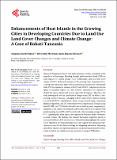Enhancements of Heat Islands in the Growing Cities in Developing Countries Due to Land Use Land Cover Changes and Climate Change: A Case of Babati-Tanzania

View/
Date
2024-12-09Author
Majula, Atugonza
Machunda, Revocatus
Selemani, Juma
Metadata
Show full item recordAbstract
Climate is changing no doubt, with anthropogenic activities considered as the main driver of the change. Flooding, drought and urban heat island (UHI) are some impacts of climate change (CC). Additionally, land use land cover change (LULCC) adds more pressure to the growing cities. Population is increasing with urban cities expected to accommodate the majority of the people while UHI is expected to increase with CC and LULCC. Adaption is the best option to minimize impacts of UHI; however, researchers are required to identify the cause, impacts and ways to cope with the impacts. Therefore, this study investigated how the Land Surface Temperature (LST) of Babati, a fast-growing town in Tanzania, is changing with CC and LULCC. Remote sensing was used with LULC classification, which was performed using a maximum likelihood algorithm, and LST retrieval involved computational formulas using bands R, NIR, and TIR. Results showed a rise in built-up areas, suggesting urbanization at the expense of farmlands and bare land. The LULCC together with global warming from 2002 to 2022 contributed to the increasing average LST by 0.7˚C signifying that more impacts are expected in the future under a business-as-usual scenario. The findings also indicate that higher vegetation density is associated with lower LST and vice versa. This relationship highlights the critical role of vegetation in regulating temperature and suggests that enhancing vegetation cover may be an effective strategy for mitigating urban heat. Improving agricultural practices as population increases and promoting sustainable urbanization in Babati and similar towns are necessary to mitigate UHI effects.
